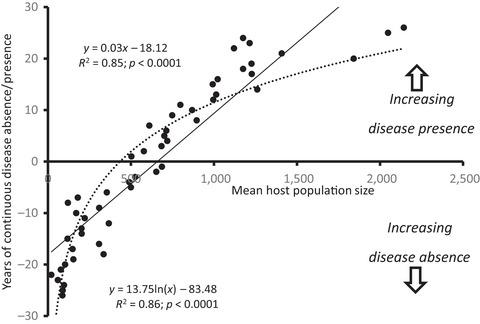Our official English website, www.x-mol.net, welcomes your
feedback! (Note: you will need to create a separate account there.)
Disease influences host population growth rates in a natural wild plant–pathogen association over a 30-year period
Journal of Ecology ( IF 5.3 ) Pub Date : 2021-10-08 , DOI: 10.1111/1365-2745.13794 J. Zhan 1 , L. Ericson 2 , J. González‐Jiménez 1 , Jeremy J. Burdon 3
中文翻译:

疾病在 30 年期间影响自然野生植物-病原体关联中的宿主种群增长率
更新日期:2021-10-08
Journal of Ecology ( IF 5.3 ) Pub Date : 2021-10-08 , DOI: 10.1111/1365-2745.13794 J. Zhan 1 , L. Ericson 2 , J. González‐Jiménez 1 , Jeremy J. Burdon 3
Affiliation

|
- The epidemiological and demographic dynamics of plant–pathogen interactions in natural environments are strongly affected by spatial and temporal influences. Here we assess the interaction between Filipendula ulmaria and its rust pathogen Triphragmium ulmariae by analysing a 30-year long dataset that has followed pathogen and plant population dynamics in a metapopulation of ~230 host patches growing on islands of the Skeppsvik archipelago in northern Sweden.
- Over this period, the host metapopulation initially expanded in both number and size of individual patches before plateauing. In contrast, the pathogen metapopulation showed greater change. Disease incidence showed a convex pattern rising for the first decade before showing a marked decline in the last decade. At the same time, the prevalence of disease in infected populations showed a constant 30-year long decline.
- At the individual host population level, each population was annually classified into one of four inter-year states: healthy, recolonization, extinction and diseased. Host populations that were healthy from 1 year to the next were significantly smaller than all other host population categories, while host populations in which disease was constantly present were significantly larger.
- Host populations in which the pathogen underwent either an extinction or a recolonization event were of similar size and represented a measure of the host threshold size for long-term pathogen survival.
- Host population growth rates declined as disease levels increased. The growth rate of host populations in which disease was continuously present was 75% lower than in populations that were free disease.
- The sensitivity of the association to climate change as demonstrated through a decline in disease incidence and prevalence and an increase in drought damage to plant populations as temperatures rise has only become apparent through analysis of an extensive long-term dataset.
- Synthesis. To date wild plant–pathogen studies have focused on the epidemiology of the pathogen and its effect on individual plant fitness. Here we have established a link to the impact of the pathogen on the long-term dynamics of host populations. This has the potential to trigger a cascade of changes in the species composition and diversity of communities.
中文翻译:

疾病在 30 年期间影响自然野生植物-病原体关联中的宿主种群增长率
- 自然环境中植物 - 病原体相互作用的流行病学和人口动态受到空间和时间影响的强烈影响。在这里,我们通过分析一个长达 30 年的数据集来评估Filipendula ulmaria与其锈病病原体Triphragmium ulmariae之间的相互作用,该数据集跟踪了瑞典北部 Skeppsvik 群岛岛屿上生长的约 230 个宿主斑块中的病原体和植物种群动态。
- 在此期间,宿主元种群最初在单个斑块的数量和大小上都扩大了,然后才达到稳定状态。相比之下,病原菌群显示出更大的变化。疾病发病率在前十年呈上升趋势,然后在过去十年显着下降。与此同时,受感染人群中的疾病流行率呈连续 30 年的持续下降趋势。
- 在个体宿主种群水平上,每个种群每年都被分为四个跨年状态之一:健康、重新定殖、灭绝和患病。从一年到下一年健康的宿主种群明显小于所有其他宿主种群类别,而持续存在疾病的宿主种群则明显更大。
- 病原体经历灭绝或重新定殖事件的宿主种群具有相似的大小,并且代表了长期病原体存活的宿主阈值大小的量度。
- 随着疾病水平的增加,寄主人口增长率下降。持续存在疾病的宿主种群的增长率比没有疾病的种群低 75%。
- 通过对广泛的长期数据集的分析,通过疾病发病率和流行率的下降以及随着温度升高对植物种群的干旱损害增加,证明了与气候变化关联的敏感性。
- 合成。迄今为止,野生植物病原体研究的重点是病原体的流行病学及其对个体植物适应性的影响。在这里,我们建立了病原体对宿主种群长期动态影响的联系。这有可能引发物种组成和群落多样性的一系列变化。











































 京公网安备 11010802027423号
京公网安备 11010802027423号